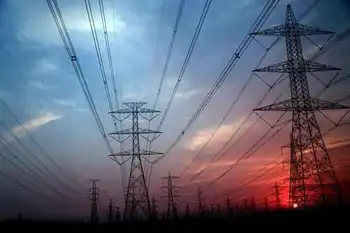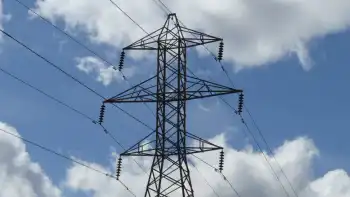Shipping nuke waste through lakes draws flak
BRUCE COUNTY, ONTARIO - The Bruce Nuclear Generating Station plans to ship 1,760 tonnes of radiation-laced steel through Lake Ontario — a precedent-setting project that has officials worried on both sides of the Canada-U.S. border.
On April 1, Bruce Power asked the Canadian Nuclear Safety Commission, CanadaÂ’s nuclear regulator, for a licence to ship low-level radioactive generators from its power plant on Lake Huron to Sweden, where 90 per cent of the metals inside the generators are to be cleansed and resold. The remaining materials that are too radioactive to be recycled will then return to the Bruce plant to be contained for the rest of their radioactive lives.
But the planned journey, which would have 16 decommissioned steam generators travel through the Great Lakes, down the St. Lawrence River and then to Sweden this fall, has municipal officials concerned because they havenÂ’t been given the chance to vet the proposal. If approved, this would be the first time a licence has been issued by the commission to ship nuclear waste through the Great Lakes.
“My frustration for years has been the lack of respect for the Great Lakes. We treat it like a toilet bowl,” said Mike Bradley, mayor of Sarnia. “We don’t give it respect and don’t treat it like there needs to be public engagement.
“The impression that I have is that this is a rubber stamp process. I think it’s unfolding in a manner that is disrespectful to the public process.”
Bradley has signed a petition to stop the shipment, which would see the waste travel through his city in September. His signature is joined by two Michigan state representatives and by a number of native leaders and environmental groups who are concerned about the risk to public safety and angry at the lack of transparency.
“The Canadian Nuclear Safety Commission is a public tribunal that is required to give notice to the public and the affected parties and allow them to comment,” said Mark Mattson, president of the Lake Ontario Waterkeeper, a Toronto-based charity working to protect the lake. “That’s sort of the legal process called fairness and transparency.”
Though the shipment would go through the jurisdictions of two countries and multiple states and provinces, the commission, which generally holds public consultations before granting licences, has designated just one person — the director of the commission’s Transport Licensing and Strategic Support Division — to decide whether the shipment will proceed.
In a statement to the Star, Bruce Power said it has not done an environmental assessment for the shipment, but added: “The important thing to remember is this is low-level radiation exposed or otherwise that is well within regulatory limits to ship.…
“If the very unlikely scenario occurred where the ship sank and the vessels were somehow breached, the very low levels of radiation would be diluted even further by the large volume of water and would result in a level of radiation that we believe would not even be measurable.”
Aurele Gervais, a Canadian Nuclear Safety Commission spokesman, also downplayed any threat to public safety, saying that “those with anti-nuclear views have a tendency to fear monger.”
In fact, Gervais added, hazardous materials — including some that are radioactive — have been shipped through the Great Lakes before. This shipment, however, requires a licence because of its size and its level of radioactivity.
Each generator, which weighs 110 tonnes and is the size of a school bus, has a 5-centimetre steel shell and any holes in those shells would be welded shut and coated with a protective substance before transport.
“If a person stood within a couple of metres of one of the generators for a two-hour period they would have received radiation levels similar to a chest X-ray,” said Murray Elston, vice-president of corporate affairs at Bruce Power.
Traditionally, CanadaÂ’s nuclear waste is stored in warehouses and underground repositories. Though recycling such materials is done in parts of Europe, the practice is controversial because the metals cannot be traced once they enter the market.
The decommissioned generators, which are more than 30 years old and being replaced as part of a refurbishment project at the Bruce plant, are currently housed in a concrete warehouse. Workers are allowed near them for short periods of time due to their radioactivity.
Gordon Edwards, president of the Canadian Coalition for Nuclear Responsibility, a watchdog group, says each generator contains thousands of small tubes through which the primary coolant flows. Those tubes have the same type of contamination that all the other pipes in the primary cooling system have — fission products that emit beta and gamma radiation and transuranic elements such as plutonium, which emit alpha radiation.
“They are harmless inside the steam generator, but once outside in the environment they are very dangerous and remain so for a very long time,” says Edwards.
The plan is to have the generators trucked in September from the Bruce plant to Owen Sound, where they will be loaded onto an ocean-going ship and sailed over three of the five Great Lakes passing by Toronto, Sarnia, Windsor, Detroit, St. Catharines, Montreal and Quebec City.
Once the radioactive waste is boarded onto the ship, Bruce Power says it assumes no responsibility for the safety or integrity of the generators or for any possible cleanup in the event of an accident during transport. That, Elston says, is the responsibility of Studsvik, the Swedish company that will recycle the material once it arrives in Sweden.
Johan Hahnel, a spokesperson for Studsvik, says his company will make sure all necessary authorities approve of the transport and that the personnel handling the equipment will be able to ensure full security of the radioactive waste.
Garry Linsey, director of maritime services for the division of the Canadian Coast Guard that oversees cleanups of hazardous materials on the Great Lakes, said in an interview Friday that he was unaware of the planned shipment.
Elston says Bruce Power, which is paying Studsvik roughly about $1 million per shipped generator, deserves some credit for the plan because it will reduce the companyÂ’s environmental footprint by ridding it and Canada of the nuclear waste.
“When people get it right there should be an ability of the citizens of this country to be informed that it is being done well that it’s being done right and, you know, you should get some accolades for reducing the environmental footprint,” he says.
Related News

Zero-emission electricity in Canada by 2035 is practical and profitable
OTTAWA - A powerful derecho that left nearly a million people without power in Ontario and Quebec on May 21 was a reminder of the critical importance of electricity in our daily lives.
Canada’s electrical infrastructure could be more resilient to such events, while being carbon-emission free and provide low-cost electricity with a decentralized grid powered by 100 per cent renewable energy, according to a new study from the David Suzuki Foundation (DSF).
This could be accomplished by 2035 by building a lot more solar and wind, adding energy storage, while increasing the energy efficiency in buildings, and modernizing provincial energy grids.…




